COLUMNS
CHALLENGES
16 August, 2013
Industrial landscape in Aliveri
I am sailing to Eretria on Evia Island. Opposite me, in the sky above the island, the South wind has brought together a series of fog clouds which are now below the mountaintops of Evia.
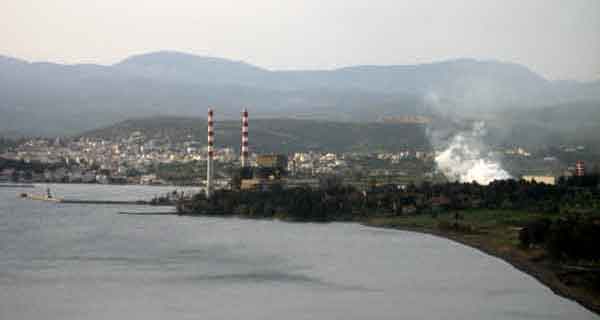
(Photo 1 -The Public Power Corporation -PPC plant in the middle of the bay, with the old power units in the port, and the new natural gas one at the point where there is the leak. The town of Aliveri, in the background.)
21 May 2012 St Constantine's Day, I am sailing to Eretria on Evia Island. Opposite me, in the sky above the island, the South wind has brought together a series of fog clouds which are now below the mountaintops of Evia.
I am alone, standing on the deck of ‘Protoporos II' ferry. The land is becoming one with the sea and you would think that smoke was coming up from the ground. Behind Mountain Olympus of Eretria, in the distance, there is the outline of the unconquered mountains of Dirfis, the villages of Kymi, and the Aegean Sea behind them. The color of Evia's Gulf grey. Sailing across the Gulf, I can see the beach and the Island of Dreams coming into view. Next, the spread out houses of Eretria. The illegal cottages in the dug-up hills. The archeological site at the foot of Olympus of Eretria. Dirfis with its subtle curves in the far, end and finally Platia - Korfi, fading out in the sea. There is an inner controlling tension connecting the mountaintops along the ridge of Platia-Korfi. Like Hymettus, Platia-Korfi is a mountain of the sea, too. The inner point of the tension, the point at which the incline changes, can be seen on the side of Amarynthos.(1) Somewhere around there the old convent of St. Nicolas was built. It's windy. Every now and then raindrops fall, brought by the south wind.
Trees are dying
On the Island of Dreams
In Eretria.
***
22th May 2012 on Karavos beach. I am sitting on the gravel of the beach adjoining the PPC plant, and I am writing next to the boat my cousin George is calking. The handmade, wooden boat stands free in the wind, secured with wedges in pebbles, and next to huge pipes left lying there to be connected to the 5th Natural Gas Unit which belongs to the PPC.
On a weekday, absolute silence reigns in the landscape. The old plant is silent. Its double high chimneys overlook the sea, and there are two older chimneys next to its main rusty volume. As I am writing I can see two huge, new pipes on the gravel. Other vertical pipes are ready, connected to scaffolding. They are across from me, in the distance, in the cordoned off with barbed wire property of the major international steel constructions METKA, across from me. In between, I can discern the low, rectangular, made of concrete, prefabricated buildings of the Ministry of Cultural Affairs! A woman opens the door and comes down some stairs. She sees me. 11THEphorate of Prehistoric and Classical Antiquities (EPCA).
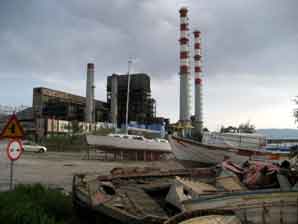
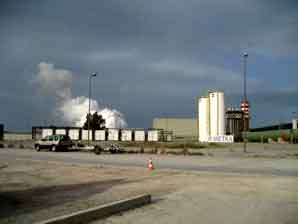
(Photo-2 the PPC plant with its old power production units, next to some new hulls and the old destroyed ones.)
(Photo-3 , 31 March 2013. The new power production unit of the PPC during connection trials and the natural- gas control cubicles. The photo was taken after the 11th EPCA relocated so that the works could be carried out.)
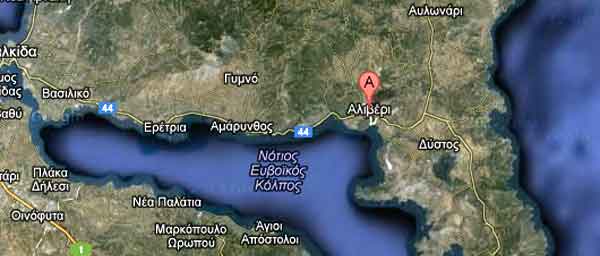
Across from me is the seascape. The Neolithic ‘Messonissi', the rock with the caves above the sea, and Karavos settlement with its red-tiled roofs in the port. Only places serving ouzo with meze and coffee shops are now left in Karavos. There are so many wooden fishing boats and caiques moored at dock. Under the law imposed in Greece by the EEC two decades ago, fishing-boat owners received a subsidy as soon as they destroyed their boats. As a result, there are only a few boats left in little harbors. Maybe here people had no reason for destroying their boats.
Messonissi rock
Belonging to the sea
Near Karavos
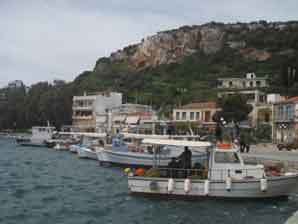
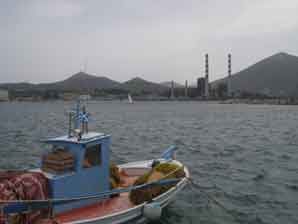
(Photo-4 Karavos under the rock of Messonissi), (Photo-5 PPC plant, seen from Karavos. Far in the gulf we can barely make out AGET- Lafargue)
Trucks and limos.
Pass by loaded. They slow down at the turning in front of the entrance to the old PPC plant and move on to the cement plant AGET(3), loaded with peat, aggregates and dirt. There is always activity in AGET, now bought by Lafargue , and it has to do with the high salaries and lump sums paid to the employees to entice them to voluntarily quit before the legal retirement age. This is how 'two-speed' citizens are created in the social cancer of dramatic Aliveri.
Two men stop at the entrance to the PPC plant, come out of their car and hang a banner on its railings: "YES, TO THE ENERGY CENTER IN ALIVERI". Power production using mazout-external combustion oil- stopped and the employees have been suspended for four years now. They receive their salaries but the factory has been inoperative, and will be so, until the completion of the natural gas installation, which will supply the fifth unit of the plant with the new fuel.
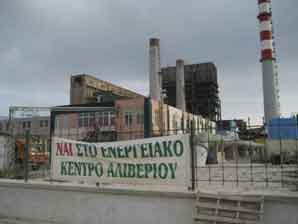
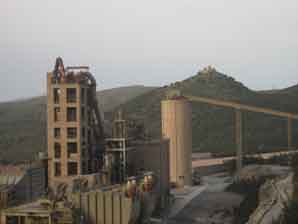
(Photo-6 entrance to the PPC plant), (Photo- 7 The cement factory AGET-Lafargue from a close view, and the medieval monument looming on the opposite hill.)
Behind the PPC facilities, the cement factory AGET-Lafargue far in the background (photo 7).On one side which overlooks the Evian Gulf the factory exploits peat lignite, a waste product from the old PPC plant, and the abundant natural minerals of the mountainous hills of Aliveri. So in a sense it's not altogether inoperative. Its humming cannot be heard though.
The perfect quiet
Of the whole landscape
It annoys me.
It is high noon and the once erotic landscape of Karavos is inoperative! Oh yes! Suddenly a firm, steady sound can be heard again, coming from the middle of the harbor. It's a constant productive sound of a drill on a barge and it's digging in the harbor of Karavos deepening it, nobody knows why. I can see it near the end of the imaginary line of Messonissi, in the centre of the landscape of my vision. I get into a writing mood again but this immobilizes me in the middle of the spherical space. Industrial landscape of Aliveri.
***
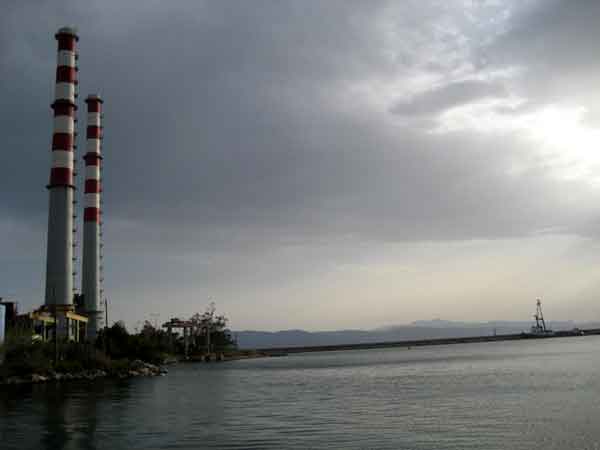
(Photo 8 The harbor of Karavos)
The woman from the Ministry of Culture is now talking aloud with the worker in charge. She is giving instructions. The workers who have turned up, some five to seven foreigners, swarthy, Pakistani workers , are next to the shacks unloading pallets. Her speech is interrupted by a Clark, which is whistling now continuously but intermittently, enhancing the landscape behind me. I notice marble slates and stones in the archeological site in the cordoned off with high barbed wire, forbidden construction area of the 5th natural gas unit, owned by the construction company METKA. Behind the low shacks I recognize some ten natural gas utility vaults connected together, in a line, similar to the ones we designed in my office twelve years ago. The workers are transferring the ancient marble on belts and then on the Clark, placing it on pallets to take it away from the site. The archeologist inspected it and then it was registered in a catalogue.
Some really significant finds must have been discovered. I later heard that in the same place, Neolithic antiquities were found during the excavations belonging to the Iron Age and they are significant for the history of the area (4).However, the town 'Porthmos'- seaport of Tamynaioi in ancient times- had already been destroyed in 1950 by the installation of the first Steam-Electric Power station of Aliveri (5).
In the substation
Engines' whistling sounds
Can be heard again.
The sea in May is cool while I am writing. There is a dizzying sun. Now I can clearly discern, between the two factory chimneys, a medieval tower with battlements and a window. It is one of the many Venetian towers springing up all over the area of Aliveri up to Kymi (6). We have lived, grown up in these towers. They have tamed the landscapes of our childhood years. We could see them on the hilltops in the distance from our classroom window or roaming the area on foot or in a car.
I 'm not surprised
By the Venetian tower
Above the chimneys.
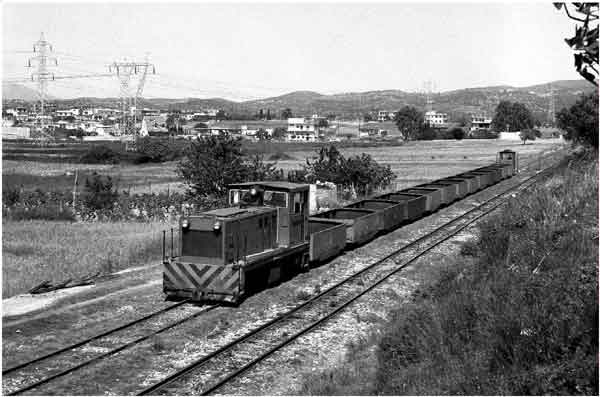
(Photo-9 The carriage transferring lignite on its journey from the lignite mines to the Steam-Electric Station of Aliveri)
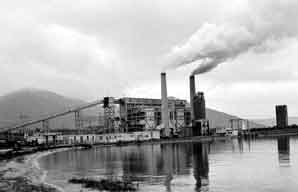
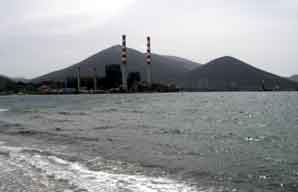
(Photo-10 Steam Electric Station of Aliveri in operation during the 1960s. Due to its construction there, a large part of the ancient settlement 'Porthmos' had to be destroyed. The medieval tower is on the beach.), (Photo-11 Two old power production units of the PPC and two recent ones with their high chimneys supplanting the medieval monument.)
No! I am not surprised!
What surprises me is that the Industrial Landscape of Aliveri hides in its sphere-from the depths of the earth to the air- everything:
Neolithic antiquities in Messonissi and in Karavos.
Venetian towers on the beach or on the hilltops.
Lignite mines on the surface of the ground or in its depths, with galleries for the mining of lignite.
Steam-Electric Industrial installations in the middle of the 20th century and oil-fueled ones in the late 20th.
Natural Gas Technology installations at the start of the 21st century.
And all these next to the sea.
There has been continuous habitation in the area for 4,500 years now, which makes the landscape last and our souls open up.
A wonderful sea between them makes you feel peaceful.
Calm, closed, deep and peaceful. Behind the pier of the natural harbor of Karavos one can gaze at the beaches of the Evian sea and at the mountain ranges of Attiki, of Ramnounda and of Parnitha. This landscape.
Now the supports
Getting rusty on the sand
Thrown away.
***
The plant hasn't operated for some four years.
Old, light facilities: prefabricated office buildings for the employees of the PPC, in front of the entrance. Cars are parked outside the railings, along with wooden caiques and other rotten ones.
Reeds next to the sea. Inside the barbed wire there are low barrels, and a bridge over the sea which lays waste. It was supposed to bear the tank truck, which emptied oil until recently.
Now, natural gas power generation will use seawater through an outdoor cooling pipe connected to the production unit. Although the unit is far from the old factory, the environment and the antiquities have not been taken proper care of.
The outdoor cooling pipe connects the old and new facilities. It starts from the fifth unit, it goes underground next to the entrance, where the seaside road is, and then goes above the ground again until it reaches the sea.
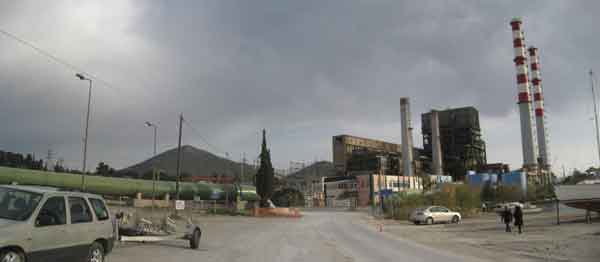
(Photo- 12 The cooling pipe goes underground next to the entrance, where the seaside road is)
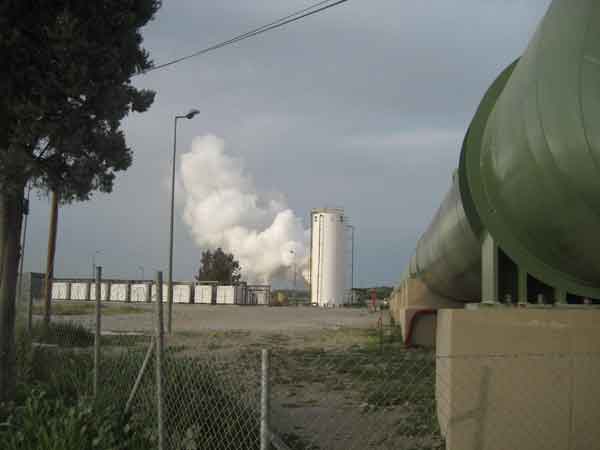
(Photo-13 The cooling pipe, and in the background its connection to the 5th natural gas unit. We can see the leak from the connection trials. March 2013)
The natural gas company had to move the pipe underground after new finds were discovered during the excavations. They placed it 10 m. deeper in order for the Neolithic settlement to remain intact. The antiquities were registered but it is essential that they be further protected and that they be made known (7).
The town of Aliveri is spread out in the background. The old town is on the hill and back in the north the light curves of the mountain range of Dirfis.
In the background
Aliveri old town
Under Dirfis curves.
LANDSCAPE DYNAMICS
22 March 2012, at the recent 'Akti Nireos' settlement. Afternoon, on the eve of Ascension Day.
The suspension of light or wind, as it comes from the valley behind the PPC plant in Aliveri, has structured me.
Andreas Empeirikos hasn't written anything about the years he spent in Aliveri, maybe because those years hurt him. He was here during the Lignite Miners' uprising against his father in the Mid-war, and the poet was at odds with him.
But I have to write about Aliveri.
About the energy of the light and the wind, which comes from north-east, from Kymi, reaches Messonissi and then arrives here. The energy of the Aegean Sea!
It can be traced behind the double tops of the hills.
It leads the last culmination of the night breeze.
Of the wind which moves the fishing boats and defines the dynamics of the sounds.
Light is clear. (9)
The factory, with its double chimneys, makes the energy of the landscape grow to gigantic dimensions.
Lignite, coal under the ground.
Prehistoric and classical antiquities hidden in the dirt.
Venetian forts from the Medieval Period dominate from the beach to the hilltops. They perpetuate a mood of the fire within us to communicate, subconsciously.
In the landscape, flames of smoke of another era-from the Homeric Age to the Medieval Period.
Venetian domination on the hilltops. Turkish dealings in the old Aliveri. Industrial boom in the 30s. Electricity production to provide the country with electricity during the 60s. Changes at the end of the 20th century, coming with the industrial energy production burning oil. The cement factory AGET-currently Lafargue- next to the PPC plant for the exploitation of its waste products and the dug-up hills.
In our days, natural gas installations and electronic control cubicles. Now that they are completed, they mark the beginning of the second decade of the 21st century, a new beginning in the financial crisis.
Nowadays languor and financial crisis in Aliveri.
Create the Dynamics of the Landscape.
Languor and crisis
Industrial landscape
In Aliveri
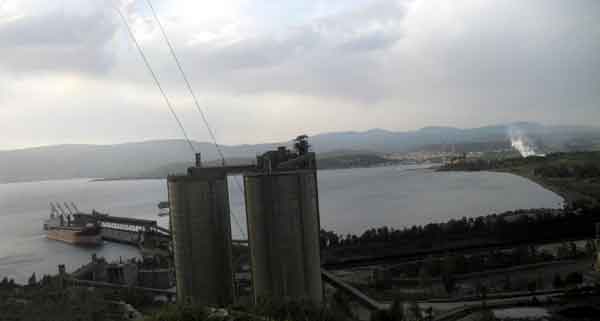
(photo-14 The AGET-Lafargue installations with the peat reserves.The PPC plant in the middle of the gulf, and the town of Aliveri in the background.)
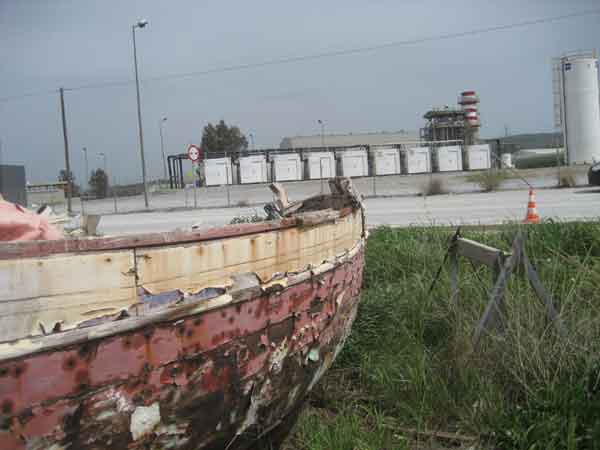
(Photo-15 The new power production unit)
by Pepe Anastasia, Architect
OBSERVATIONS-BIBLIOGRAPHY
(1)The continuation of Platia-Korfi, at the point where it connects to Dirfi, is called Mount "Kotylaio" and on it there are ruins of an ancient temple dedicated to goddess Diana. Today there is a small village, "Partheni" which used to be a town in the ancient times, and which probably was related to the worship of goddess Diana. However, 'the most important goddess of Evia, Diana, was honored most greatly in ancient Amarynthos, in the temple of "Amarynthia Diana", which was further north, according to Jules Girard. He was a French historian, archeologist and professor of Ancient-Greek Poetry in Sorbonne who, at the age of 27 in 1852, published this in his work 'History of Ancient Evia', which was translated into Greek by G.I. Foussara. See ARCHIVES OF EVIAN STUDIES, VOLUME 11, Athens 1964. Amarynthos.
(2)Margarita Pournara 'Trawls, purse seines, and fishing boats with acetylene lamp die ashore' KATHIMERINI 7.8.2011. With the blessing of the Greek state and the European Community more than 5,000 wooden fishing boats have been destroyed in the last 20 years. The history of the annihilation of the fleet of fishing boats, a fleet which remains the greatest in Europe as it consists of about 17,500 vessels, started in the 1990s. During the last twenty years we have lost more than 3,750 fishing boats. We have lost knowledge that had been passed on from one generation to the other, since wood had been the first shipping material for thousands of years. Although a policy was planned to protect the flora and fauna of the sea bottom, it did not provide for the protection of our cultural heritage.
(3)The old AGET-HRACLES was built right next to the old PPC plant and it exploited the peat which came from the burning of lignite during its operation and also the abundant aggregates, from the surrounding hills to produce cement. ROPTRO, no 38, see article by Spiros Konstantopolos 'Steam-Electric Station of Aliveri, Dec. -2012.
(4) For more details about the important archeological find, refer to the book by the archeologist Athina Chatzidimitriou 'Aliveri, contribution to the archeological research of the area', 1990.
Also, on the Internet, the Society of Evian Studies makes clear its position regarding the significance of the recent important archeological finds in Karavos, Aliveri. The finds were found during the excavations by contractors when they were placing a gas transmission pipeline (20.11.2012)."With the intervention of the 11th EPCA, finds dating to the Middle Helladic Period were uncovered (2.500BC -2.100BC). They are of unique archeological and historical importance for the area. The finds are particularly important given the total destruction of the town of the classical period "Porthmos", seaport of Tamynaioi- which occurred during the construction of Steam-Electric Station of Aliveri in the 1950s. "The new finds along with finds from previous excavations prove that habitation in the area of Karavos has been continual since the Iron Age'.This has been published in the recent studies of Nota Kourou, and other studies by Giorgos Papavassiliou (1909) and Dimitri Theoharis.
(5) Porthmos, important port of ancient Evia belonging to Eretrians. Recent discoveries place it next to Karavos.
(6) The Venetian Tower on the beach and on the hill next to the little harbor of Aliveri. Jules Girard 1852, published this in his work 'History of Ancient Evia', which was translated into Greek by G.I. Foussara. See ARCHIVES OF EVIAN STUDIES, VOLUME 11, Athens 1964. Tamynes.
(7) The cultural society of Aliveri claims responsibility for the further protection and show of the Neolithic settlement in the location of the excavations.
(8)TO DENTRO, Athens 2000 issue 110 includes the text: 'I remember a man enormously affectionate!' where poet Andreas Empeiriko's son, Leonidas, talks to Tassos Goudelis about his father: 'The second uprising against his father's business was when for ideological reasons the poet worked as a worker in the lignite mines of his father. That period he also wrote 'The Red Song'. The following instance was In the newspaper 'Class Struggle' 1933 "on 10-8-1933 the police attacked workers of the lignite mines. About 20 workers were injured and one died".
The above facts are confirmed by the poet himself in his book PHOTOPHRAKTIS, THE FOTOS OF ANDREAS EMPEIRIKOS, AGRA publications 2001, in which he writes '... just before 1934 strikes broke out in the lignite mine and I found myself in a difficult position as on the one hand I wanted to be true to my ideal and on the other I did not want to dissatisfy my father. I quit and devoted exclusively to literature and psychoanalysis'.
(9) 'Stravonas says that Tamynes was a temple of Apollo' Jules Girard writes.
PHOTOGRAPHIC MATERIAL
The photographs were taken by the author ten months after the text was written. It was not 21st &22nd May 2012 but 30th & 31st March 2013. The wind happened to be the same though. It kept only the outlines, taking out volume from the buildings and the landscape.
Naturally, the huts (for the archeologists) have been removed and the antiquities have been transferred somewhere else until the completion of the project. The gas leaking into the air during the time the picture was taken is evidently steam from the unit connection trials.
The AGET-currently Lafarge- cement factory uses aggregates reserves coming coming from the burning of lingnite (until these become exhausted). The panoramic photos are taken from the periphery road of AGET and they show the bay of Aliveri.
Related articles:
- Industrial Building on the fringes of Attiki Odos ( 15 November, 2009 )
- MEDICAL INSTRUMENTS FACTORY AT RAFINA, ATTICA ( 20 October, 2009 )
- Reutilisation of the building T.A.O.L. in Lefkada ( 23 June, 2010 )
- Routes in the paths of emery ( 01 February, 2011 )
- Urban integration and reuse of the former paper industry of Ladopoulos in Patras ( 20 February, 2011 )
- The old factory of Azel ( 04 April, 2011 )
- Restoration and reuse of the Tzivre silk mill in Soufli ( 14 June, 2011 )
- Project Suggestion for Reusing KOMDE’s industrial complex in Trikala ( 16 August, 2011 )
- Mining Museum in Serifos ( 15 February, 2012 )
- Multi-space of Meditteranean Diet in metropolitan park in Goudi ( 05 March, 2012 )
- Subverting the non use ( 26 March, 2012 )
- Cultural Park in inactive lignite mines of Ptolemaida ( 27 September, 2012 )
- Winery in Nemea ( 01 May, 2012 )
- Industrial landscape in Aliveri ( 16 August, 2013 )
- Memory nd urban sityscape ( 24 May, 2013 )
- Decontamination and Production Mechanism ( 05 February, 2014 )
- Reformation and rehabilitation of an inactive quarry, with spatial location of uses for Tourism, Recreation and Environmental Education ( 10 February, 2014 )
- Redesigning the silo at the historic Allatini Mills ( 09 May, 2014 )
- Restructuring the Industrial Landscape ( 19 July, 2014 )
- inte[R]outes ( 11 December, 2014 )
- Lato and Kekrops Quarries: a walk in the residual landscape ( 28 January, 2015 )
- Print your utopia ( 07 February, 2015 )
- ADAPTIVE REUSE OF A FORMER PAPER FACTORY IN AIGIO AND CONVERSION TO REHABILITATION CENTRE FOR DISABLED PEOPLE ( 12 August, 2015 )










